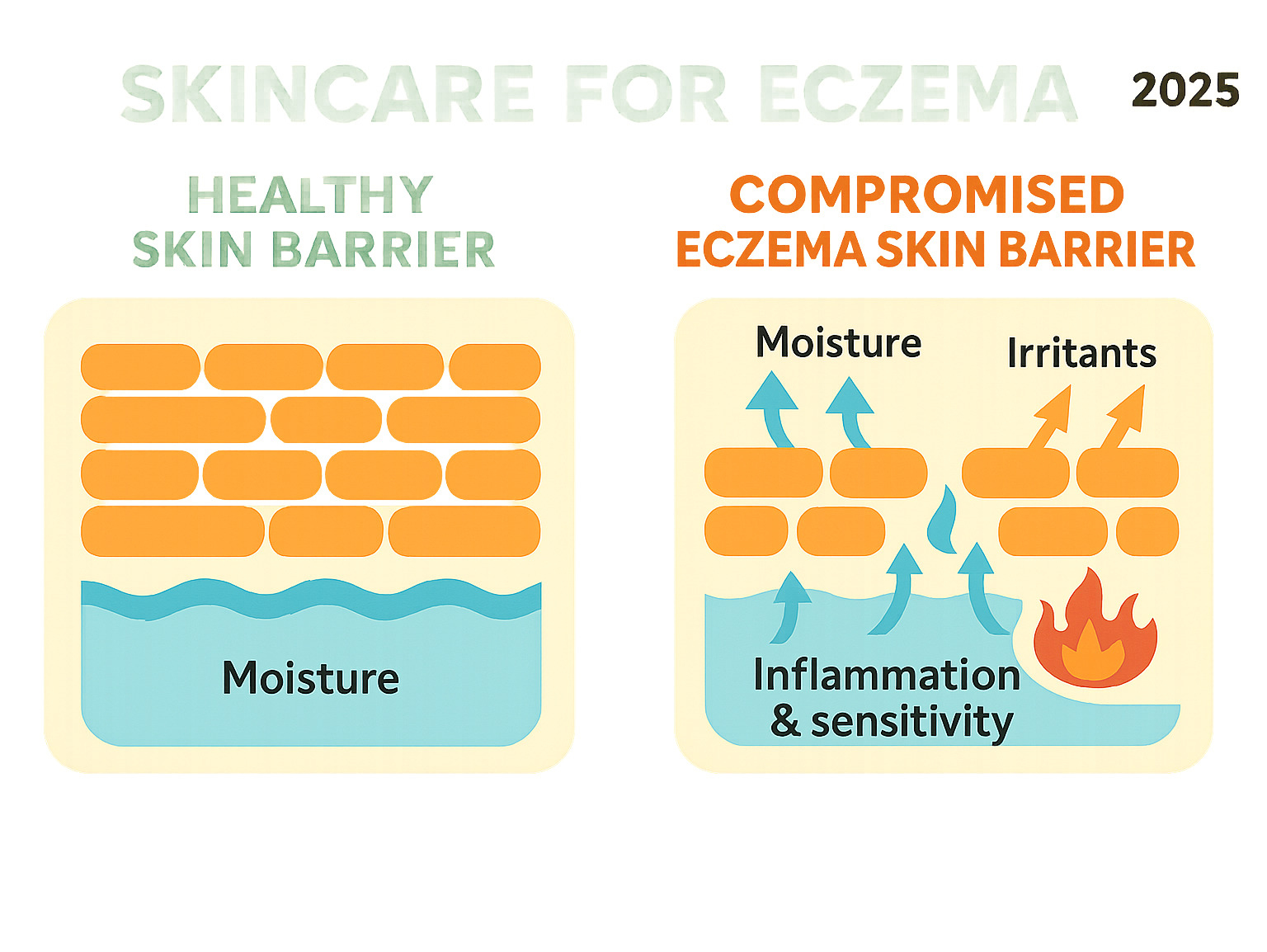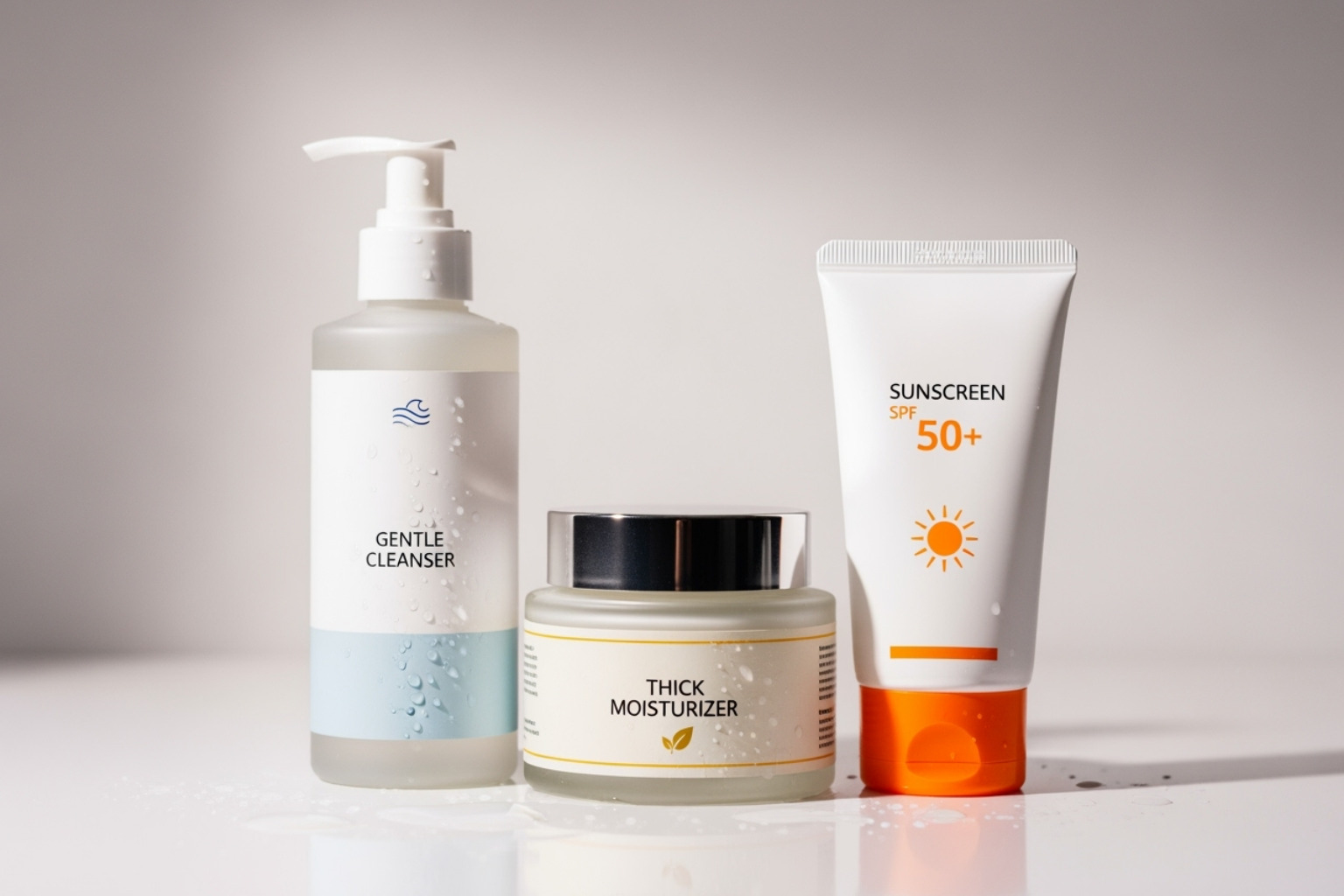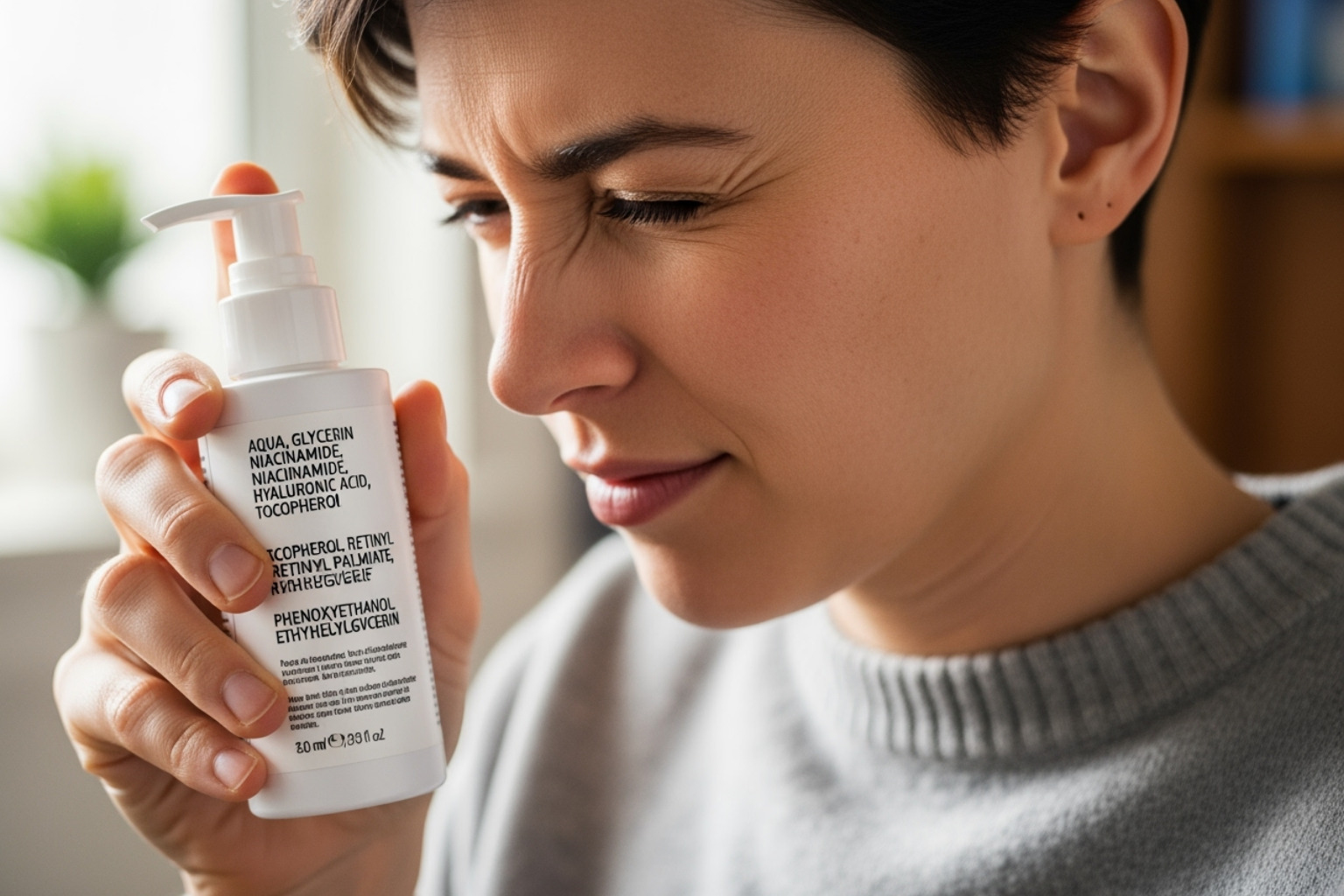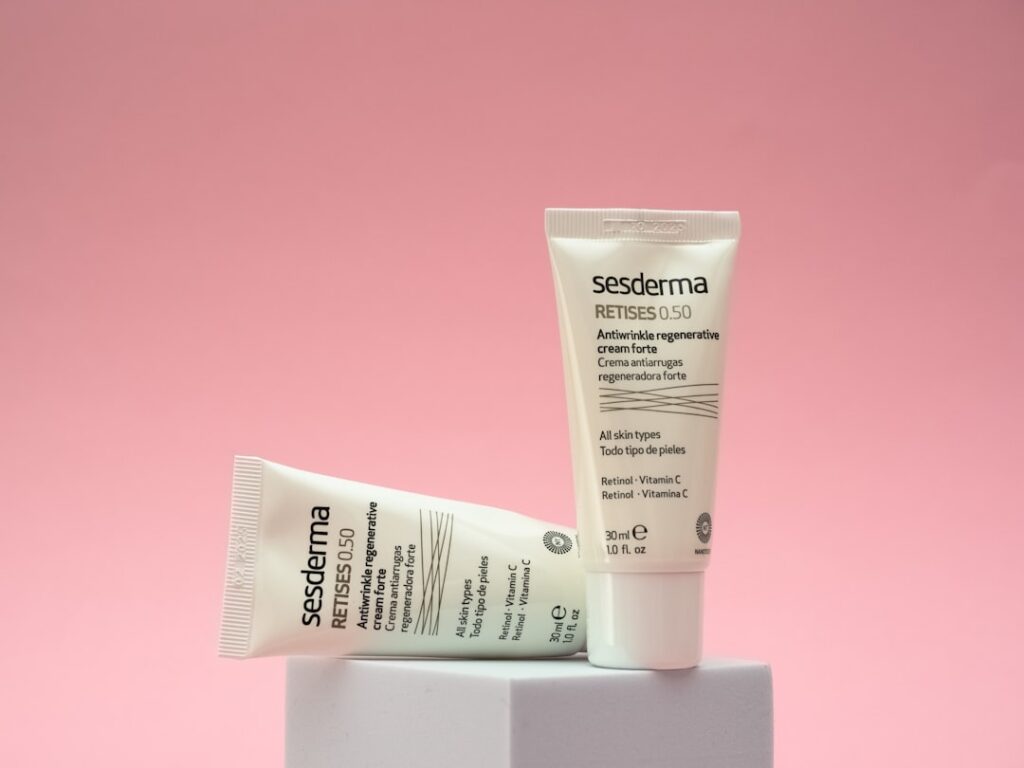Why Understanding Your Skin Barrier is the Key to Managing Eczema
Skincare for eczema starts with understanding what’s happening beneath the surface of your irritated skin. If you’re dealing with red, itchy patches that seem to flare up without warning, you’re not alone – eczema affects approximately 31.6 million Americans.
Quick Guide to Eczema Skincare:
- Cleanse gently with lukewarm water and fragrance-free products
- Moisturize immediately after bathing (within 3 minutes)
- Protect daily with mineral sunscreen (SPF 30+)
- Avoid triggers like fragrances, harsh soaps, and wool fabrics
- Look for ingredients like ceramides, colloidal oatmeal, and hyaluronic acid
The root of eczema lies in a compromised skin barrier – think of it as your skin’s protective wall having tiny cracks that let moisture escape and irritants sneak in. This creates the perfect storm for inflammation, dryness, and that maddening itch.
But here’s the good news: with the right approach, you can strengthen that barrier and find real relief.
Eczema presents differently across skin tones too. While lighter skin typically shows red or pink rashes, deeper skin tones may experience brown, purple, or gray patches. Understanding these variations helps you recognize and address your specific needs.
The key isn’t just finding products that work – it’s building a consistent routine that repairs your skin barrier while avoiding the triggers that set off flare-ups in the first place.

Skincare for eczema definitions:
Understanding Eczema and Its Triggers
When you’re dealing with skincare for eczema, it helps to understand what’s happening with your skin. Eczema isn’t just “dry skin” – it’s a chronic condition where your skin barrier doesn’t work as it should. Think of it as a leaky roof that lets moisture escape while allowing irritants to sneak in.
What are the common symptoms of eczema?
Eczema shows up differently for everyone. You might notice intense itching that appears suddenly, followed by redness and inflammation. Many people experience dry, flaky patches that feel rough, especially on delicate areas like the face, neck, and around the eyes.
It’s important to know that eczema looks different depending on your skin tone. Lighter skin typically shows red or pink rashes. On deeper skin tones, flare-ups might appear as brown, purple, or gray patches, so the classic “red rash” description doesn’t apply to everyone.
The itching – or pruritus – can be particularly intense on facial areas. You might notice very dry patches with small blisters around your nose, ears, cheeks, or eyelids. The discomfort is real.
What causes facial eczema?
The cause is complicated. Eczema happens when genetic factors meet environmental triggers. Your immune system overreacts, treating harmless substances like dangerous invaders.
There are two main types. Atopic eczema (atopic dermatitis) is the most common and often genetic. It can flare up from stress or environmental factors. Your immune system and skin barrier work closely together, so when one is disrupted, the other often follows.
Contact eczema occurs when your skin has a hypersensitive reaction to something it touches. It’s a two-step process: first exposure sensitizes your skin, then future contact triggers the flare-up.
For more detailed information about different eczema types, the American Academy of Dermatology has excellent resources.
Is facial eczema contagious?
Let’s be clear: No, eczema is absolutely not contagious. You can’t catch it from or pass it to others. It’s your body’s internal response to genetic and environmental factors, not an infection spread between people.
So go ahead and hug your loved ones without worry. Your eczema is yours alone to manage.
What are some common triggers for eczema flare-ups?
Understanding your triggers is key to avoiding flare-ups. Fragrance tops the list, including synthetic and “natural” types in skincare and laundry detergents. Even air fresheners can be a problem.
Harsh detergents and soaps strip your skin’s natural oils, weakening its barrier. Stress is another major culprit, as your skin and emotions are closely connected.
Wardrobe choices matter. Fabrics like wool can cause irritation, while breathable cotton is gentler. Environmental factors like dry air, extreme temperatures, and airborne allergens can also set off flare-ups.
Other triggers include metals (like nickel in jewelry), dyes, and some antibacterial products.
Become a detective with your own skin. Pay attention to what precedes your flare-ups to see patterns that can help you avoid future problems.
The 3-Step Routine: A Gentle Approach to Skincare for Eczema

With eczema, your skincare routine is your daily armor against flare-ups. It gives your compromised skin barrier the gentle care it needs to heal and protect itself. The beauty of skincare for eczema is its simplicity: three essential steps to soothe, repair, and shield your sensitive skin.
Consistency is everything when managing eczema. Your skin thrives on this three-step routine – cleanse, moisturize, protect – which creates a foundation to prevent flare-ups.
Step 1: Cleanse Gently
Your cleansing routine sets the tone. The goal is to remove impurities while preserving the natural oils your skin barrier needs.
Lukewarm water is your best friend. Hot water feels soothing but quickly dries out sensitive skin. Keep baths and showers between 5 and 10 minutes to avoid over-drying.
After bathing, don’t rub with a towel. Instead, pat your skin gently, leaving it slightly damp. This creates a perfect base for your moisturizer.
Your cleanser choice is critical. Harsh soaps and strong detergents are enemies of eczema-prone skin. Look for gentle, fragrance-free options that don’t leave skin feeling tight or stripped. Your skin should feel soft after cleansing, never irritated.
If you’re exploring gentler options for your sensitive skin, you can explore clean beauty for sensitive skin to find products that work with your skin, not against it.
Step 2: Moisturize Effectively
This is where the magic happens. Moisturizing is crucial for eczema management – it’s often the difference between calm skin and an itchy, inflamed flare-up. For mild eczema, a good moisturizing routine alone can control symptoms.
Understanding moisturizer options helps you choose the best one for your skin. Lotions are light and absorb quickly but are often too weak for eczema. Creams offer a good balance of moisture without feeling too heavy for daily use. Ointments have the highest oil content, perfect for very dry, cracked skin, but can feel greasy.
As one dermatologist puts it, “the thicker the better” when it comes to eczema moisturizers. Ointments are particularly effective as they are petroleum-based with low water content, so they don’t sting irritated skin and create an excellent protective barrier.
The “Soak and Seal” method is a game-changer. After a lukewarm bath, pat dry, apply any prescription medications, then slather on your moisturizer within three minutes. This timing is key to trapping moisture before it evaporates.
Moisturize 2 to 3 times daily, or when skin feels itchy or dry. Apply with gentle, downward strokes. Use a clean spatula for jars to avoid contamination.
The importance of moisturizing for eczema cannot be overstated – it’s truly the cornerstone of effective eczema management.
Step 3: Protect Your Skin
Your cleansed and moisturized skin needs protection. Daily sunscreen is not optional, as UV radiation can worsen eczema symptoms and increase skin damage risk.
Choose a broad-spectrum, mineral sunscreen with SPF 30 or higher. Zinc oxide and titanium dioxide create a physical barrier, blocking harmful rays without the irritation chemical sunscreens can cause.
In cold, dry weather, your skin is more vulnerable. Cover exposed skin with soft, breathable fabrics like cotton, which won’t chafe or irritate. Clothing is another protective layer, especially in harsh weather.
This simple three-step approach is powerful. Eczema-prone skin needs consistent, gentle care to support its natural healing, not complicated routines.
Decoding Labels: How to Choose Eczema-Friendly Products

Standing in the skincare aisle with eczema can feel overwhelming. Every bottle and jar promises relief, but how do we know which ones will actually help versus make things worse? The secret lies in becoming a savvy label reader – and trust me, it’s easier than you might think!
The golden ticket we should always look for is the National Eczema Association (NEA) Seal of Acceptance. When you spot this little badge of honor on a product, it’s like finding a trusted friend in a sea of unknowns. These products have undergone rigorous scientific review to ensure they’re formulated with ingredients suitable for sensitive, eczema-prone skin. They’re specifically free of those sneaky ingredients that love to cause trouble for us.
Here’s a crucial distinction that trips up many of us: fragrance-free versus unscented. If a product says fragrance-free, it means no fragrance ingredients were added – this is what we want for our skincare for eczema routine. But unscented? That’s trickier. These products might contain masking agents to hide other smells, which can still irritate our sensitive skin.
We should also keep an eye out for hypoallergenic labels. While the FDA doesn’t regulate this term, manufacturers typically use it to indicate they’ve formulated the product to minimize allergic reactions. For those of us wanting to dive deeper into safe product selection, you can Learn about non-toxic skincare principles that align perfectly with eczema care.
Key Ingredients for Your Skincare for Eczema
Think of these ingredients as your skin’s best friends – they’re the ones working hard behind the scenes to repair, soothe, and protect your compromised skin barrier.
Ceramides are like the building blocks your skin is desperately craving. Our eczema-prone skin often has lower levels of these essential lipids, so products rich in ceramides help rebuild that protective barrier while delivering deep hydration.
Hyaluronic acid is a moisture magnet that can hold up to 1,000 times its weight in water. It pulls moisture from the air and locks it into your skin’s surface, giving you that plump, hydrated feeling we’re all after.
When your skin is angry and itchy, colloidal oatmeal swoops in like a gentle superhero. This finely ground oat flour creates a protective barrier, calms inflammation, and provides serious itch relief. It’s been used for centuries, and there’s a good reason why – it works!
Niacinamide (also known as Vitamin B3) is a true multitasker. It reduces redness, calms inflammation, and helps strengthen your skin barrier – all without the side effects that come with steroid treatments. It’s like having a gentle, effective treatment that plays well with other ingredients.
Don’t overlook simple but powerful ingredients like glycerin, which draws moisture into your skin, and petrolatum, which creates that protective seal we talked about earlier. Shea butter rounds out this dream team by providing rich, nourishing moisture that helps keep your skin soft and supple.
Many of these powerhouse ingredients come from natural sources, offering gentle yet effective benefits. You can explore more about the Benefits of plant-based ingredients to understand how nature supports healthy skin.
Ingredients and Triggers to Avoid
Just as important as knowing your skin’s friends is recognizing its enemies. These are the ingredients that can turn a good skin day into a flare-up nightmare.
Fragrance tops the troublemaker list, whether it’s synthetic or natural. You might see it listed as “fragrance,” “parfum,” or even “natural fragrance” – but for our sensitive skin, they’re all potential problems. Fragrance is one of the most common causes of allergic contact dermatitis, and it can make existing eczema symptoms much worse.
Alcohol in skincare products (especially those drying alcohols in toners and astringents) can leave your skin feeling tight, burning, and more irritated than before. Your already compromised skin barrier doesn’t need this extra stress.
Some ingredients that work well for others might not play nice with eczema-prone skin. Lanolin and urea are common allergens for people with eczema, even though they’re meant to be moisturizing. Dyes and artificial colors can trigger reactions, while sulfates in foaming cleansers can strip away your skin’s natural protective oils.
Propylene glycol appears in many moisturizers and creams, but it can cause allergic reactions in some of us. It’s one of those ingredients that sounds harmless but can be surprisingly irritating.
Triggers extend beyond just skincare products. Stress, certain fabrics (especially wool), harsh household cleaners, and even metals like nickel can all contribute to flare-ups. For a comprehensive guide to what to avoid, check out these 8 skincare ingredients to avoid with eczema.
The key is to become your own skin detective. Start reading those labels, and soon you’ll be able to spot the good guys and avoid the troublemakers with confidence.
When to Consult a Dermatologist

Sometimes, even with the most dedicated skincare for eczema routine, we need to call in the professionals. There’s no shame in seeking help – in fact, it’s one of the smartest moves we can make for our skin health.
Think of it this way: we wouldn’t try to fix a complicated plumbing issue without a plumber, so why struggle alone with persistent skin problems?
When It’s Time to Pick Up the Phone
Persistent eczema that doesn’t respond to our gentle routine and over-the-counter treatments is a clear signal to schedule that appointment. If we’ve been consistently following our three-step routine for several weeks without improvement, it’s time for professional guidance.
Severe itching that keeps us awake at night or interferes with our daily activities deserves immediate attention. When the itch becomes so intense that it affects our quality of life, a dermatologist can provide stronger anti-itch solutions that we simply can’t get from the drugstore.
Signs of infection are particularly concerning and require prompt medical care. If we notice increased redness, warmth, swelling, pus, or honey-colored crusting around our eczema patches, these could indicate a bacterial infection that needs antibiotic treatment.
What to Expect During Your Visit
Walking into a dermatologist’s office for the first time can feel intimidating, but knowing what to expect can help ease those nerves. Your dermatologist will start with a thorough examination of your skin and a detailed discussion about your symptoms, medical history, and potential triggers.
Skin tests for allergens might be recommended, especially if contact eczema is suspected. These patch tests can identify specific substances that trigger your flare-ups, giving you valuable information for avoiding future reactions.
Prescription Treatment Options
While our gentle routine forms the foundation of eczema care, sometimes we need stronger reinforcements. Topical corticosteroids like triamcinolone or stronger concentrations of hydrocortisone can quickly calm severe inflammation and itching during acute flare-ups.
Calcineurin inhibitors such as Elidel or Protopic offer a non-steroidal alternative that’s particularly useful for sensitive areas like the face. These medications can be used for longer periods and help prevent recurrences.
For that maddening itch that just won’t quit, dermatologists can prescribe products containing pramoxine, which blocks nerve endings to provide relief. Oral antihistamines might also join the treatment plan for severe itching episodes.
If bacterial infections develop in cracked, damaged skin, antibiotics or antiseptics become necessary to clear the infection and prevent complications.
For moderate to severe eczema that doesn’t respond to other treatments, biologics like Dupixent target specific parts of the immune system. Phototherapy, which involves controlled ultraviolet light exposure under medical supervision, can also help calm stubborn inflammation.
Personalized Advice That Makes All the Difference
Perhaps the most valuable part of seeing a dermatologist is receiving personalized advice custom specifically to your skin’s needs. They can fine-tune your daily routine, recommend specific products that work best for your skin type, and help you identify and manage your unique triggers.
Your dermatologist becomes your partner in creating a comprehensive plan that goes beyond just treating symptoms – they help you understand your skin and develop long-term strategies for keeping it healthy.
Ready to find professional help? You can Find a dermatologist near you and take that important step toward better skin health.
Frequently Asked Questions about Skincare for Eczema
We get it – managing eczema can feel overwhelming, and you probably have a million questions swirling around in your head. Don’t worry, we’ve all been there! Let’s tackle some of the most common concerns we hear about skincare for eczema.
Is eczema on the face contagious?
Here’s some reassuring news: No, eczema is absolutely not contagious! You can’t catch it from someone else, and you can’t pass it along either. We know it might look concerning when you’re dealing with red, inflamed patches, but eczema is actually your body’s internal response to genetic and environmental factors – not something caused by bacteria or viruses that can spread.
Think of it this way: eczema happens because of how your immune system reacts and how your skin barrier functions. It’s not an infectious condition at all. So go ahead and hug your loved ones, share that face towel (though we recommend everyone has their own for hygiene reasons), and don’t worry about “giving” anyone your eczema.
Which is better for eczema: a cream or an ointment?
This is honestly one of our favorite questions because the answer can make such a huge difference in how your skin feels! The truth is, ointments generally win the effectiveness battle, especially when your skin is really struggling.
Here’s why ointments are often the MVP: they have a much higher oil content and create an incredibly strong moisture barrier on your skin. This makes them ideal for those really dry, cracked areas that just won’t seem to heal. Plus, because they contain less water and alcohol, they’re much less likely to sting when you apply them to already irritated skin.
But let’s be honest – ointments can feel pretty greasy, and not everyone loves that sensation, especially during the day or in warmer weather.
Creams offer a nice middle ground. They’re less greasy than ointments but still provide good hydration and protection. They’re perfect for daily use and when you want something that absorbs a bit more readily into your skin.
Our practical approach? Use ointments for your most stubborn dry patches and for overnight treatment when you don’t mind the greasiness. Save creams for your regular daily moisturizing routine. Many of us find this combination works beautifully!
How can I manage the intense itch of an eczema flare-up?
Oh, the itch – we feel your pain! That maddening sensation can honestly drive anyone to distraction. The good news is there are several strategies that can provide real relief.
First and most importantly, try your absolute hardest not to scratch. We know this feels nearly impossible when your skin is screaming for attention, but scratching only makes inflammation worse and can lead to infections. Instead, try gently patting or pressing the itchy area – it can provide some relief without causing damage.
A cold compress can be your best friend during intense flare-ups. Just grab a clean, damp cloth and apply it to the itchy area for immediate cooling relief.
When it comes to products, look for ones containing colloidal oatmeal – this ingredient is fantastic at forming a protective barrier while actively relieving that itch sensation. Products with pramoxine are also incredibly helpful because they actually block nerve endings, reducing the itch signal your brain receives.
Don’t forget about the ‘soak and seal’ method we discussed earlier. This technique of bathing briefly in lukewarm water and immediately applying moisturizer can significantly rehydrate your skin and calm that angry itch.
If the itching is severe or interfering with your sleep, please don’t suffer in silence. A dermatologist can prescribe stronger anti-itch medications or other treatments that can provide the relief you desperately need. Sometimes we need more powerful tools in our toolkit, and that’s perfectly okay.
Conclusion

Living with eczema doesn’t mean accepting a lifetime of discomfort. The journey to healthier, calmer skin starts with understanding that our skin barrier needs extra love and attention – and we absolutely have the power to give it what it needs.
Throughout this guide, we’ve explored the key practices that can transform your daily routine. Gentle cleansing with lukewarm water sets the foundation, while consistent moisturizing using the “soak and seal” method becomes your skin’s best friend. Those few minutes after bathing are precious – that’s when our skin is most ready to drink in all that nourishing moisture.
Trigger avoidance might feel overwhelming at first, but it gets easier once you know what to look for on labels. Skip the fragrances, harsh alcohols, and mystery ingredients. Instead, accept those skin-loving heroes like ceramides, colloidal oatmeal, and hyaluronic acid that actually help repair and strengthen your skin barrier.
The power of a personalized routine cannot be overstated. What works beautifully for your friend might not be perfect for your skin, and that’s completely normal. Your eczema journey is uniquely yours, and finding the right combination of products and practices takes patience – but the results are so worth it.
Some days will be better than others, and that’s part of the process. The key is staying consistent with your routine, even when your skin feels calm. Prevention is always easier than treatment, and your future self will thank you for the care you’re showing your skin today.
At Beyond Beauty Lab, we believe in a holistic approach to skin health that honors both the science of skincare and the wisdom of gentle, natural practices. True beauty radiates from healthy, comfortable skin that feels as good as it looks.
Ready to continue your journey toward healthier skin? We’re here to support you every step of the way. Find more natural skincare solutions and find how nurturing your skin can become a beautiful act of self-care that fits seamlessly into your daily life.







